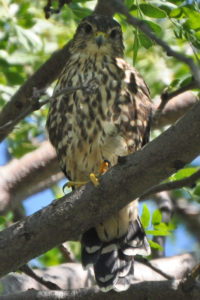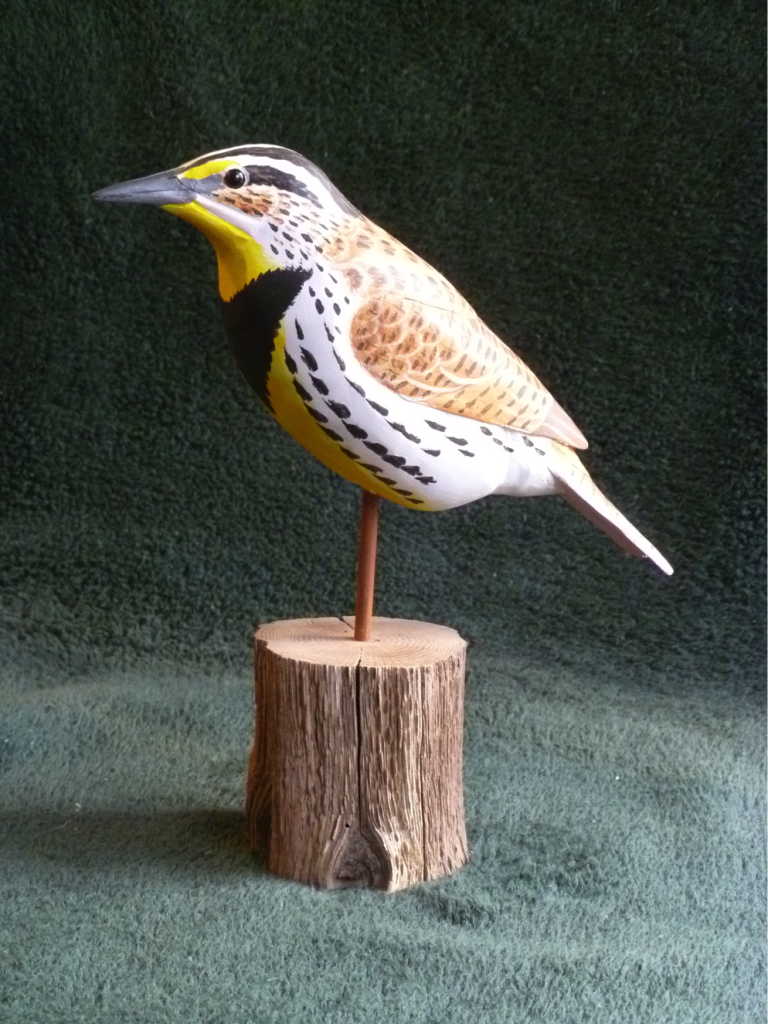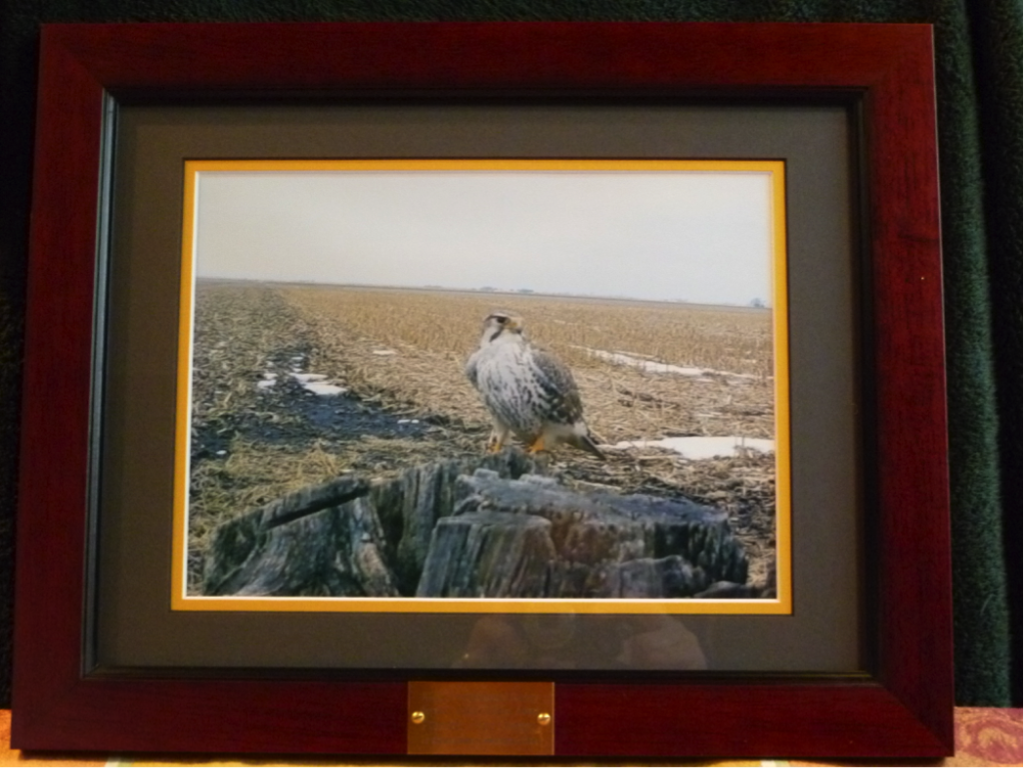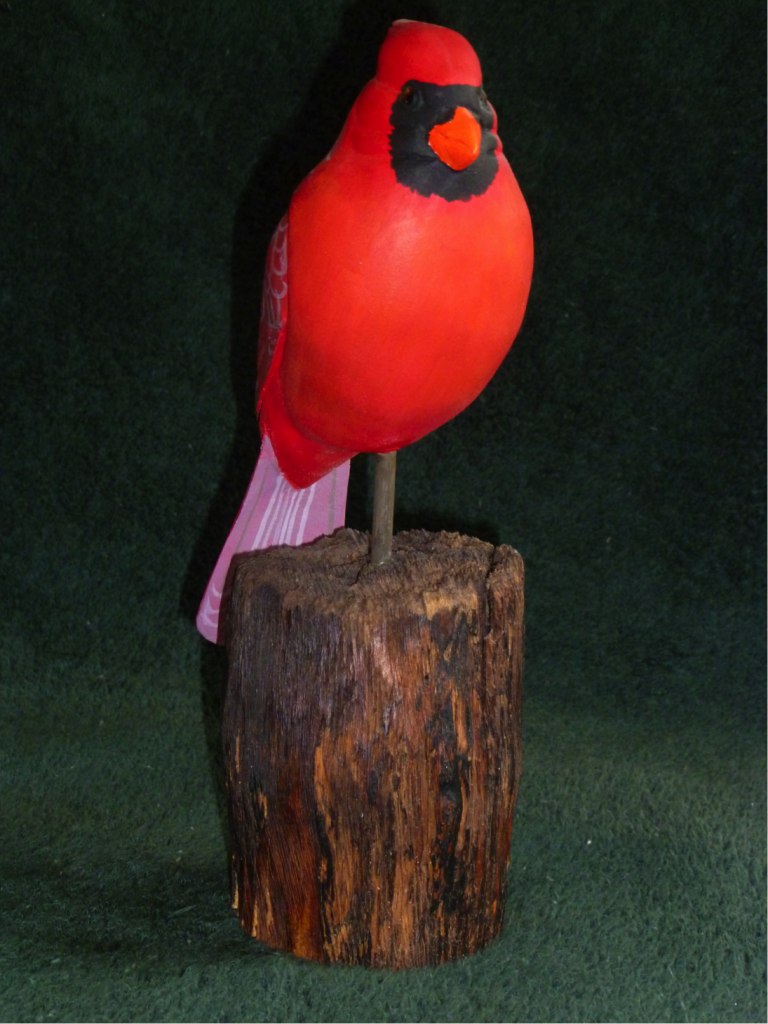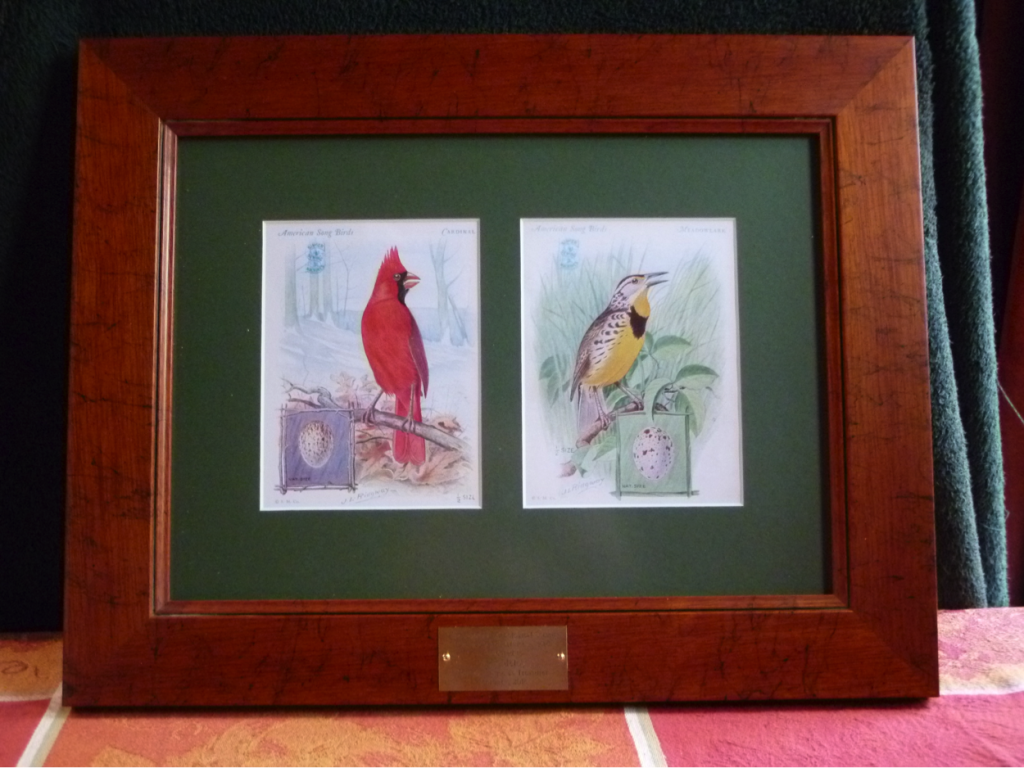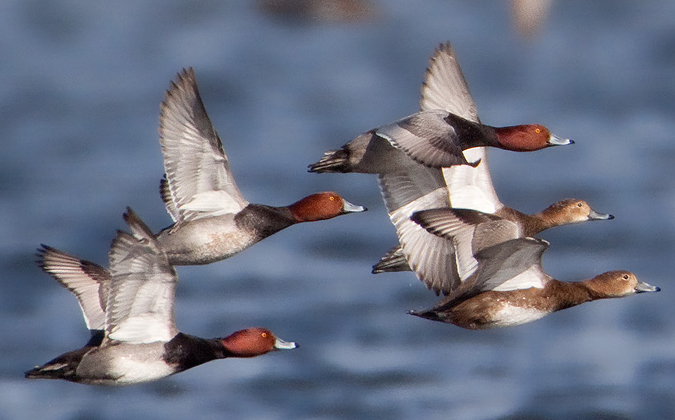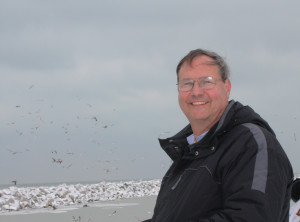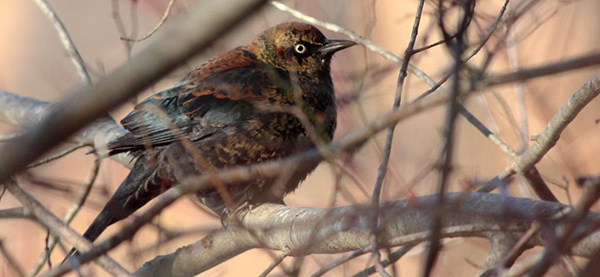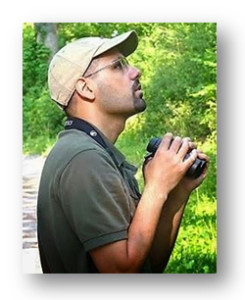Knox County CBC Musings by Mike Baum
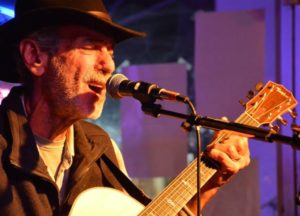
Riley and I left Chicago a little after 4 AM Monday, Dec. 12th and arrived at the Victoria grasslands shortly after sunrise. A hectic magical big-city weekend filled with parties, shopping, good food, languorous fires, Christmas lights… and SNOW! Ellen Baum and I had both planned to travel out Sunday afternoon. She stuck to her plan and headed for Pennsylvania. Made it but not without some white-knuckle driving near the end – her story to tell. I opted for a decent Blackhawks game, reheated Thai, a dying last fire, and a start in the dark. That worked, too.
Monday was the second day of the Knox Co. CBC (Christmas Bird Count) week. The count day was to be Wednesday, but a list is kept for the three preceding and three following days. I was particularly eager to bird my area after a six month hiatus from this hobby. The first stop rekindled my enthusiasm. A partly open pond east of Victoria held a big flock of geese of four species. Among the ducks were two ruddies and a ring-neck. Three ring-billed gulls flew over, a harrier made a pass, and a kingfisher rounded out the bounty. My enthusiasm, on hold since May, returned full-force.
I spent all day combing my territory: north of Victoria, then south down County 15 past Little John, and back to Oak Run where I often live. Highlights included three more kingfishers, two great blue herons, a lone robin, three Cooper’s hawks, two eagles, two fox sparrows, and a pileated woodpecker in my yard.
Spoon Lake added new ducks: one common and two hooded mergansers, five shovelers, three buffleheads, and seven common goldeneyes. I dropped Riley at the ranch and headed for Rask’s wetland west of Victoria. There is a dammed pond here set way back from the road, surrounded by cattails and nice grassland. A modest creek bleeds off it and comes west to the road, disappearing under it. I parked on the left shoulder so I could look without getting out of the car. In spite of the cold, this creek was open, terminating in a verdant pool spattered with bright green duckweed. I began taping for a swamp sparrow. Something splashed just inside the cattail edge. I stared. Nothing. My attention returned to the sparrow quest. Then something moved, giving me the briefest tease. It had some size to it. I immediately thought, “Rail”, and played a Virginia rail call. Out stepped a SORA! It stood in full view at thirty feet for several seconds.
Soras are fairly common in season. Don a pair of Wellies and walk wetlands, and you will find them. But not in winter. Jim Mountjoy did a quick search of Bohlen’s “Birds of Illinois” and eBird and found only one record, from a CBC in Rantoul in 1912! He came out to look for the bird but failed. But failed is a relative term, because as he taped, a marsh wren flew in responding to marsh wren background noise on his sora recording! He called me and I joined him quickly to enjoy this second wonder. Alas, neither of these birds was relocated, but they certainly brightened our all-time Knox CBC week list (begun in 2002) bringing our total to 122 species.
Jim and I parted and my afternoon continued. Thinking about conditions, one thing I noticed throughout the day was frozen green grass. November was so mild to the last. Friends and I had golfed at the end of the month in short sleeves on a 75 degree day. Then December came in like a lion and flash-froze all the lush greenery.
Late afternoon as I sat scanning open fields, trying to turn blowing leaves into longspur flocks, I saw three deer heading across the road in full flight. A doe led the way, followed by a young buck and a barrel-chested twelve-pointer. As he sprinted across the plowed field, with each hoof strike he atomized dirt clods like Hostess Sno Balls with firecracker centers.
The sun dipped stage left prompted by a near-full moon stage right. Coyotes too eager to wait for darkness loosed their primordial caroling from three compass points. I, in most of the clothes I own, scanned a prairie plot for short-eared owls. After twenty minutes my shivering reached the point where my binoculars were striking me in the forehead. The faintest of breezes whispered in my ear, “I could kill you if I wanted to.” Alas, the owls refused to witness this.
I returned to Victoria early Tuesday morning for another go at the owls. I missed them last year. They are most active at dawn and dusk, so the window is brief. Forty-five minutes later the sun wished me good morning, and my window slid owllessly shut. So it goes.
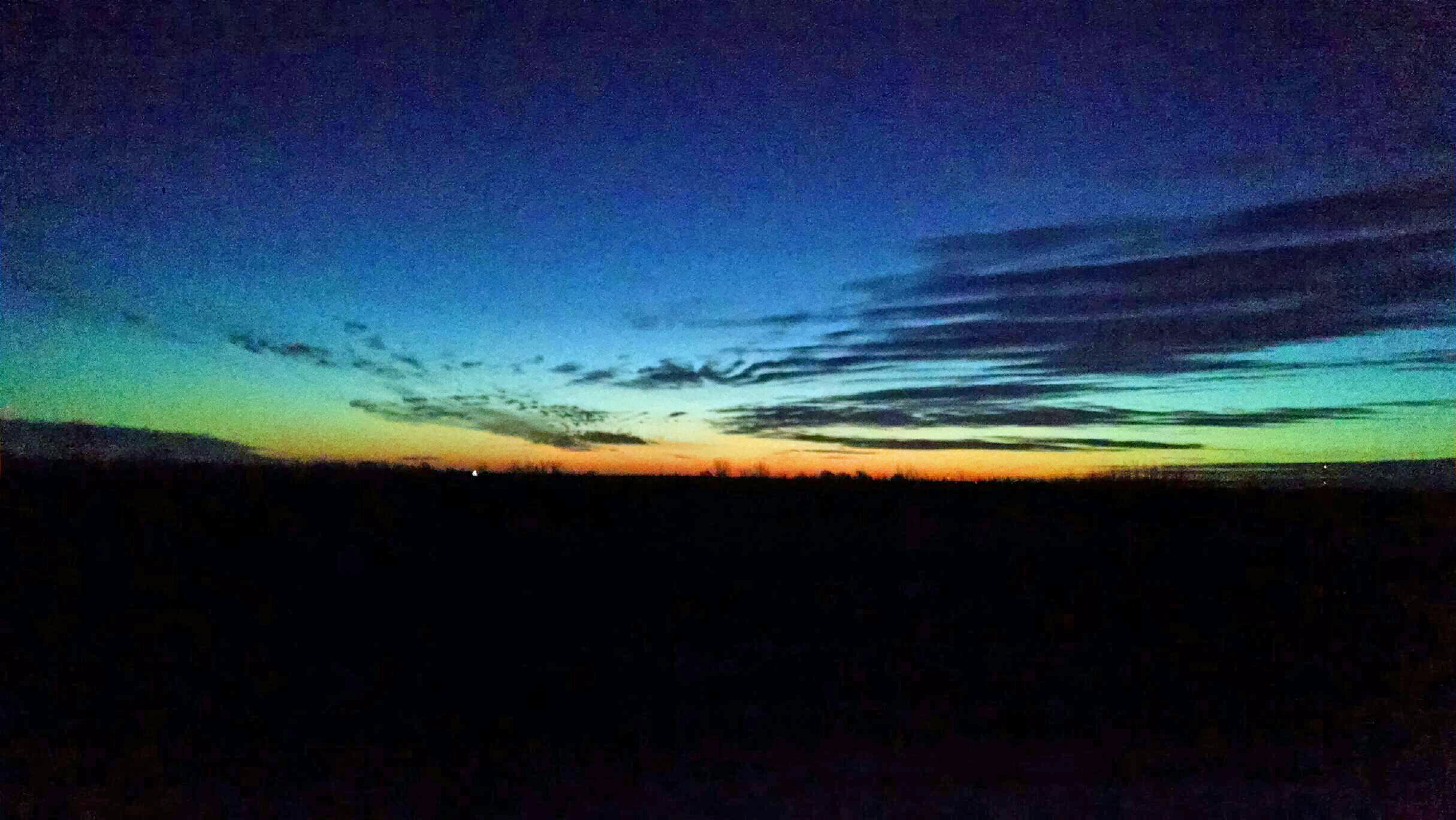
I rechecked ponds and could see that I was witnessing ice-up. Open water was disappearing quickly. My most productive pond from yesterday was reduced to a small pool packed with geese. Most of the ducks were gone. But then four trumpeter swans, elegant and ghostly in the early morning light, passed right over me.
I returned to the sora/marsh wren site but had no fortune other than a late muskrat. I continued south on 2400N and made a left on 1400E. I drove 1/10th of a mile and and spotted a bird T’d up on the top of a scrawny little tree and knew I had a prize. My glasses soon confirmed a northern shrike. This unique songbird/predator has proven to be quite regular in the county in winter, but is always a joy to find. Turns out it was a first of the year for me and worthy of another call to Jim, who came out and refound it, a first of the year for him as well.
I did a cursory audit of Spoon Lake and returned home by 9:30. I was tired, it was cold, and I had chores. I opted for an easy day and fully charged batteries for the count. I kept an eye on my deck, noting that “my” purple finches and one lone white-throated sparrow were coming in, as well as a tardy chipmunk. To my delight, late in the afternoon a Carolina wren visited for the first time in many days.
Wednesday, 3:30 AM, I arose and made much coffee. My deck snapped, crackled, and popped when I stepped out to check the weather. A full moon posed high in the sky, my wind chimes hung in silence, but the cold was profound. I put out an extra ration of bird seed and walked the BBD, listening for owls. I smiled as I recognized the return of my child-like enthusiasm. Contigo moving mug, journal, clipboard, pen, check-list, Jim’s CBC tally form, food, binoculars, spotting scope – check. Five AM, let the count begin!
I circled Spoon Lake, stopping and listening, Soon enough, barred and great horned owls broke the perfect silence. I will never tire of this. I finished my lake circuit and headed north to the grasslands a little before six. The sky was just paling on the east horizon. Time for yet another go at short-ears. I never stop hoping. This morning I tried the Rask/Fredrick wetlands first. The habitat is great, the results not so much. I only had time for one more site, so I floored it for 1700E between 2300N and Highway 167, ten minutes away. I cruised slowly along the one mile stretch, windows down, heat on max. Nothing, nothing, nothing, BIRD! I popped out of the car and brought this floppy moth-like wraith into focus. Success at 6:30 straight up. Ah, the rush of a good bird, hard-sought!
I cruised the rest of Coal Road as the firmament worked through a palette of obsidian, cobalt, a smear of turquoise, and then a blush of peach. A thin buffy yellow heralded the return of the sun for what it was worth. Light yes, and useful. Heat not so much. Harriers began turning up. It would be a good day for them, in fact unprecedented on the count. Our circle wound up tallying 32. I feel certain that many of them had just arrived from up north.
I returned to 2400N shortly after sunrise and immediately relocated the shrike. This can be devilishly hard because they hunt territories of many square miles. Ever the optimist I returned to the sora spot. I walked in some distance on both sides of the creek but could see that even this magic water was losing the battle to the cold. After twenty minutes of trying not to fall over or break through the ice I returned, birdless, to the car. So it goes… and sometimes doesn’t.
I moved on east and was not surprised to see all of the ponds iced up. I hoped that the strip mine pond off 2250N just west of 180 would still have an open pool. It did but was shrinking quickly. The geese were now shoulder to shoulder. No snow geese. They would elude all of us this day. And the duck list didn’t take long: mallard, gadwall.
I worked south on County 15 headed back toward Oak Run. A half mile north of the Fremont T by Little John I braked for a big flock of roadside birds. Usually these are juncos and American tree sparrows with the occasional goody. But in this bunch there were fifteen white-crowned sparrows and a fox sparrow – nice! Then a small but menacing raptor flashed in. The flock panicked off, and the would-be killer perched, giving me a great look at the day’s only sharp-shin.
On my way again, I found a lone red-winged blackbird near a feeder by the Sherwood Youth Camp. Later at dusk as I sped to the dam for a last look at waterfowl, I encountered a phenomenon that has happened in other recent years. Hundreds of blackbirds were streaming northwest between the dam and Brentwood Park on their way to roost. I managed to ID eighteen grackles before the light failed. I wrote down a frustrating 1600 icterid species. I never did have a cowbird on the day.
The youth camp has almost always contributed good birds on the count, but not this day. It was time for my first look at Spoon Lake. Starting at Windemere Park I could see significant increase in freeze. Waterfowl variety here was not good. I drove Oak Run Drive to the beaver pond. This is my go-to spot for great blue heron even in years when the lake is 100% ice. It is also a painless acquisition. I parked next to the guard rail, rolled down my window, and there it was, standing knock-kneed in a pretty pool.
I continued around the lake to Knollcrest Circle. The thing about Oak Run is, there are a couple of places where one can easily scan the lake, but there are many stretches where one must peer through trees and between houses. Ducks will be scattered all over the lake, and this is how to find them. Knollcrest produced the count’s only green-winged teal, wigeon, and lesser scaup. The dam was next and here the lake was wide open. A slow careful scoping yielded more treasures: common and hooded merganser, ruddy duck, common goldeneye, and two lovely drake redheads. As I sorted through geese up on a lawn I stumbled on two foraging bluebirds. Then a kingfisher rattled by. Good stuff!
I wheeled around to Brentwood and had a Cooper’s hawk zip by. I jumped out to look at it and heard a curious grunting overhead. Passing right over me were eleven trumpeter swans beating steadily and powerfully down to the lake.
There is a big stand of white pines off south Oak Run Drive. I walk through it every count. It has to be the biggest pine woods in the county and can contribute birds not to be found elsewhere. This count there were no birds. But there was something else. I have had this thought before but was glad to revisit it. A winter walk through a conifer grove needs no other reason than the doing of it. It is reverential. Add the sound of the wind and you rival the magic of the surf on any beach.
Lakeview boat launch was next up and contributed my day’s only bald eagle and buffleheads. At one PM it was time for lunch with Riley. I needed white-throated sparrow, purple finch, and Carolina wren, all of which have been in my yard for weeks. I gave the BBD a leg stretch, restocked seed, heated beef stew, and pulled up a chair to stare at my deck. The sparrow, a window-strike survivor, politely showed. I taped for the wren… crickets. I walked around the yard taping for the finches, daily visitors (I have ten of them as I write this). Aragorn voice-over, “But not this day!”
I reviewed my notes and tallied up fifty-four species as of two PM, a respectable total. I made note of my misses, reloaded the contigo, and headed back out. Over the next three hours I only added six species. Winter afternoons are tough. A revisit to the 2250N goose pond was worthy. I hopped the fence to see over the high edge, knowing a number of birds were out of sight from the road here. To my delight staring back up at me were a coot and a hen canvasback! My waterfowl list for the day finished at sixteen, and that without snow goose, shoveler, and ring-necked duck, all seen on Monday. A very nice total.
I spun around Spoon Lake one last time as dusk was coming on. This was when I had the flights of blackbirds. The grackles passing over brought my final total to sixty species for the day. Back at the ranch I let Riley out one more time, grabbed a bottle of wine, and headed for Galesburg. Jim and Jennifer graciously host a chili dinner/compilation every year, welcoming us to gather around a fire and put our count together. Jim’s chili is reason enough to do this count.
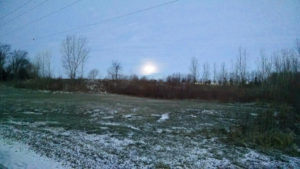
Forms were observed. Jim opened his laptop and started through the check-list, asking each party for their results one species at a time. Prior to this secrecy is maintained, so that everyone is hearing the results for the first time. At the end we put together seventy-three species, seven short of our record best, but a fine total on a challenging day. Later we learned Alice Larson had a pine siskin, lifting us to seventy-four. Eight other species went on the count week list and just now I’ve had a sapsucker in my yard, also new. Jim had the bird of the day, a saw-whet owl at Little John predawn, giving us five kinds of owls. We also had ten different diurnal raptors, another highlight. While there were certainly many other birds we could have found (again, our all-time count week list stands at 122), I felt we only had two regrettable misses: pheasant and Lapland longspur.
And now, Friday night, I am off to the Beanhive open mic and a party with dear friends. Thank you, Lord God for these days at play in your fields! I love my life! Merry Christmas!

